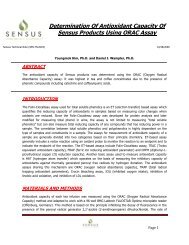Total polyphenol content in ready to drink teas determined by ...Folin ...
Total polyphenol content in ready to drink teas determined by ...Folin ...
Total polyphenol content in ready to drink teas determined by ...Folin ...
You also want an ePaper? Increase the reach of your titles
YUMPU automatically turns print PDFs into web optimized ePapers that Google loves.
Analytical Methods:1. Fol<strong>in</strong>-Ciocalteu method: <strong>Total</strong> <strong>polyphenol</strong> <strong>content</strong> (also known as <strong>to</strong>tal soluble phenolics)was determ<strong>in</strong>ed us<strong>in</strong>g Fol<strong>in</strong>-Ciocalteau assay as described <strong>by</strong> Swa<strong>in</strong> and Hillis (4). In brief,300 µL of each tea was added <strong>to</strong> test tubes and mixed with 1mL of 0.2N Fol<strong>in</strong>’s reagent.After 3 m<strong>in</strong> of reaction, 1 mL of sodium carbonate solution was added <strong>to</strong> s<strong>to</strong>p the reactionand <strong>to</strong> develop characteristic blue color for 7 m<strong>in</strong>. Seven mL of purified water was addedafter that. Absorbance was measured at 726 nm and the <strong>to</strong>tal phenolic <strong>content</strong> wascalculated based on slope from serial dilution of a gallic acid standard. The f<strong>in</strong>al value wasexpressed as gallic acid equivalent.2. HPLC green tea analysis: Each green tea <strong>in</strong>fusion was diluted 3-fold with reverse osmosis(RO) water and filtered through a 0.45 μm PTFE syr<strong>in</strong>ge filter (Whatman, Clif<strong>to</strong>n, NJ) prior<strong>to</strong> <strong>in</strong>jection. Polyphenolic separations was conducted on a Agilent 1200 HPLC system us<strong>in</strong>ga Agilent G1315B Diode Array Detec<strong>to</strong>r (DAD) with a Dionex 250 x 4.6 mm Acclaim 120-C 18column with a flow rate of 0.8 mL/m<strong>in</strong>. A gradient mobile phase consisted of Phase A (100%H 2 O) and Phase B (60% Methanol and 40% H 2 O) each adjusted <strong>to</strong> pH 2.4 us<strong>in</strong>g o-phosphoric acid. The gradient started <strong>by</strong> runn<strong>in</strong>g 0% Phase B for 1m<strong>in</strong>, 0-30% Phase Bover 30m<strong>in</strong>, 30-80% Phase B <strong>in</strong> 15m<strong>in</strong>, 80-100% Phase B <strong>in</strong> 15m<strong>in</strong>, followed <strong>by</strong> a 5 m<strong>in</strong>uteequilibration time with 100% phase A for a <strong>to</strong>tal run time of 65m<strong>in</strong>. Polyphenol compoundswere detected and quantified at 280 nm aga<strong>in</strong>st external standards of gallic acid,theobrom<strong>in</strong>e, (−)-epicatech<strong>in</strong>, (−)-epigallotcatech<strong>in</strong> gallate, (−)-epigallocatech<strong>in</strong>, (−)-epicatech<strong>in</strong> gallate, and caffe<strong>in</strong>e, all procured from Chromadex (Chromadex Inc., Irv<strong>in</strong>e,CA).3. HPLC black tea analysis: Each black tea <strong>in</strong>fusion was also properly diluted and <strong>in</strong>jected <strong>to</strong>Agilent 1200 HPLC system with a ES <strong>in</strong>dustry FluoroSep-RP 150 X 4.6mm 5µm column witha flow rate of 1.0 mL/m<strong>in</strong>. A gradient mobile phase consisted of Phase A (97% water, 2%Ace<strong>to</strong>nitrile, 1% Methanol, and 0.1% phosphoric acid), Phase B (100% Ace<strong>to</strong>nitrile), andPhase C (100% methanol) each adjusted <strong>to</strong> pH 2.4 us<strong>in</strong>g o-phosphoric acid. <strong>Total</strong> run timewas 38m<strong>in</strong> and <strong>polyphenol</strong> compounds were detected and quantified at 278 nm aga<strong>in</strong>stexternal standards of theaflav<strong>in</strong>, theaflav<strong>in</strong> monogallate, and theaflav<strong>in</strong> digallate, allprocured from Chromadex (Chromadex Inc., Irv<strong>in</strong>e, CA).RESULTS AND DISCUSSIONOverall, <strong>to</strong>tal <strong>polyphenol</strong> <strong>content</strong> determ<strong>in</strong>ed <strong>by</strong> the Fol<strong>in</strong>’s method showed significantlyhigher quantity compared <strong>to</strong> the value <strong>by</strong> HPLC analysis (Figure 1). Accord<strong>in</strong>g <strong>to</strong> Brunswicklabora<strong>to</strong>ry, one of the largest antioxidant research facilities <strong>in</strong> the nation, the Fol<strong>in</strong>’s method isdef<strong>in</strong>ed as “the Fol<strong>in</strong>-Ciocalteu measures reduc<strong>in</strong>g capacity, which has normally been used <strong>to</strong>estimate phenolic <strong>content</strong>s of biological materials.” S<strong>in</strong>ce the Fol<strong>in</strong>’s method detects not only<strong>polyphenol</strong>ic compounds but also other biological compounds that have reduc<strong>in</strong>g power such asam<strong>in</strong>o acids, carbohydrates, ascorbic acid, and sapon<strong>in</strong> which are all naturally present <strong>in</strong> tea, thevalue <strong>by</strong> Fol<strong>in</strong>’s method might be higher than the value <strong>by</strong> HPLC. An addition of ascorbic acid <strong>to</strong>RTD <strong>teas</strong> and us<strong>in</strong>g color<strong>in</strong>g material such as caramel color also <strong>in</strong>creases the value <strong>by</strong> Fol<strong>in</strong>.Copyright <strong>by</strong> SENSUS, LLC.7255 Hamil<strong>to</strong>n Enterprise Park DriveHamil<strong>to</strong>n, OH 45011Tel: 513-892-7100www.sensusflavors.com2



